Lessico
Ipocisto
Cytinus hypocistis
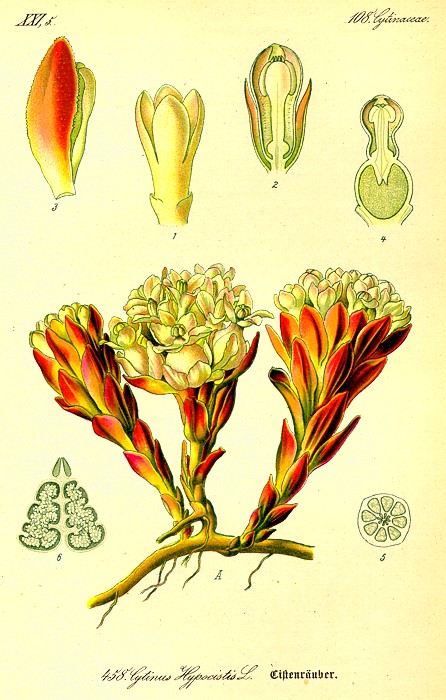
Cytinus
- forse dal greco kýtos = cavità, involucro, coppa - è un genere di
piante della famiglia Rafflesiacee. Il cosiddetto ipocisto, Cytinus
hypocistis, è l'unico rappresentante della famiglia presente nella nostra
flora ed è presente anche in altre parti della zona mediterranea e in Africa.
Ha fusto ingrossato alto 5-8 cm, foglie squamiformi prive di clorofilla,
rossastre, carnose, embricate, fiori giallastri o rossicci. Vive parassita
sulle radici di Cistus![]() .
.
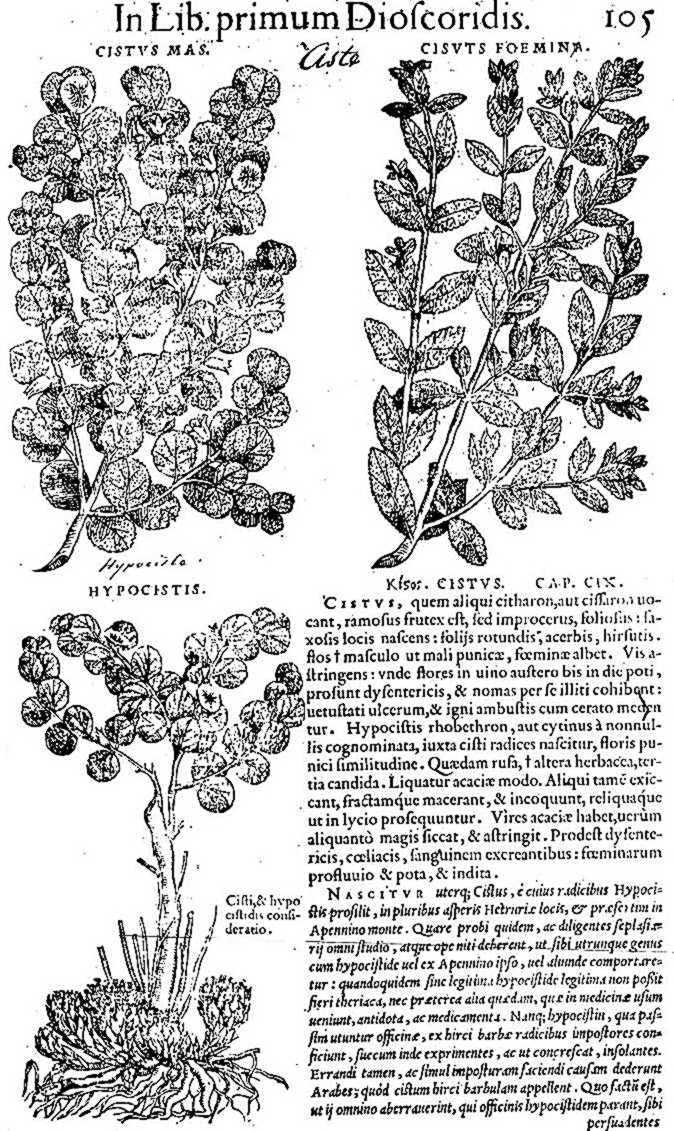
Pierandrea
Mattioli![]()
Commentarii in libros sex Pedacii Dioscoridis Anazarbei
De Materia Medica
Venetiis, apud Valgrisium, 1554
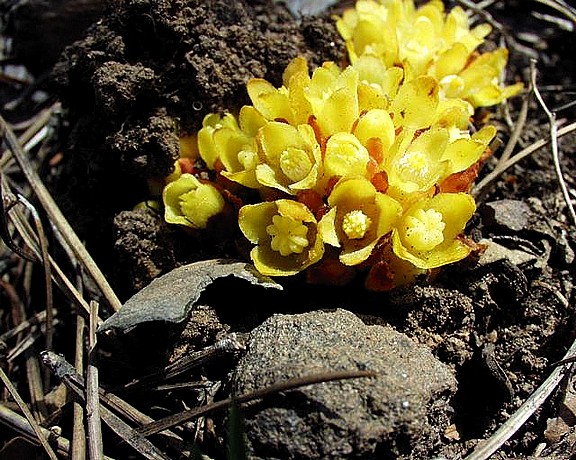
Cytinus hypocistis
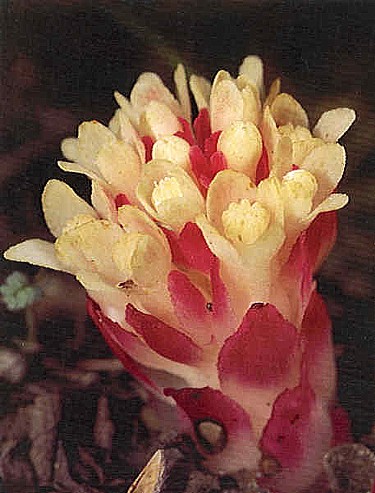
La famille des Cytinacées est une famille de plantes dicotylédones qui comprend 10 espèces réparties en 2 genres: Bdallophytum, Cytinus.
Ce sont des plantes parasites sans chlorophylle, des régions tempérées à tropicales, originaires du bassin méditerranéen, du Mexique, d'Afrique du Sud et de Madagascar. En France elle est représentée par la Cytinelle (Cytinus hypocistis) parasite du ciste à fleur blanche sur le pourtour méditerranéen.
Précédemment incorporées dans les Rafflésiacées, la classification phylogénétique APG II (2003) les situe pour l'instant dans les familles de position incertaine (ou les Malvales d'après le site AP-Website).
Cytinelle
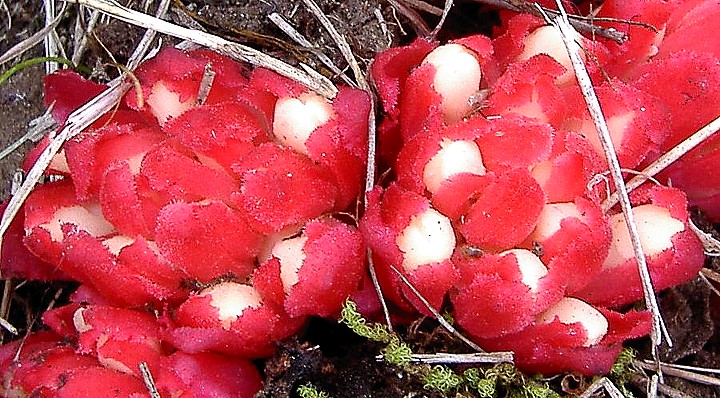
La cytinelle ou cytinet (Cytinus hypocistis) est une plante parasite de Cistus salviifolius classiquement placée dans la famille des Rafflésiacées. Les derniers travaux en phylogénie ont provoqué l'éclatement de cette famille et la cytinelle, seule représentante du genre Cytinus en France, est placée dans la famille des Cytinacées.
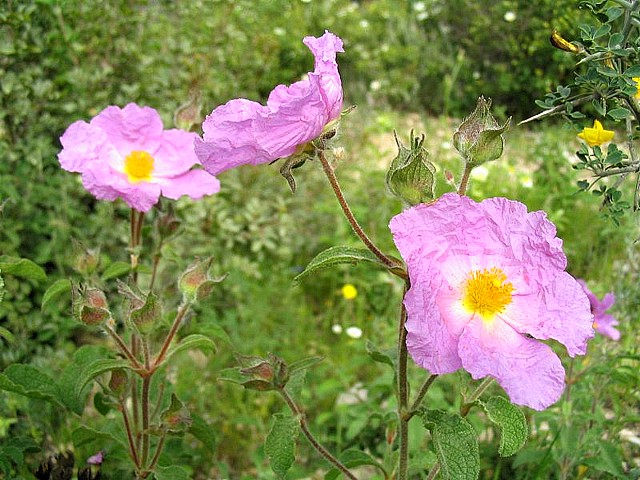
Cistus incanus
Il nome deriva dal greco kístis, vescica, in riferimento alla forma delle capsule che racchiudono i semi. Il cisto (Cistus L., 1753) è un genere di piccoli arbusti o frutici sempreverdi appartenente alla famiglia delle Cistaceae. I cisti hanno fiori vistosi, a simmetria raggiata, con calice persistente a 3-5 sepali, corolla dialipetala a 5 petali bianchi o rosei, androceo con numerosi stami poco sviluppati in lunghezza, ovario composto da 3-5 carpelli sormontato da uno stilo semplice. Il frutto è una capsula a 5 valve contenente più semi.
Sono piante sociali della macchia sempreverde. In Italia si ricordano: Cistus salvifolius (scornabecco o brentine); Cistus monspeliensis (cisto marino, brentine), ghiandoloso, a foglie lanceolate e a fiori bianchi dal quale si ricava un balsamo resinoso detto ladano (in greco lëdanon, in arabo ladan), usato in profumeria; Cistus incanus, a fiori rosei.
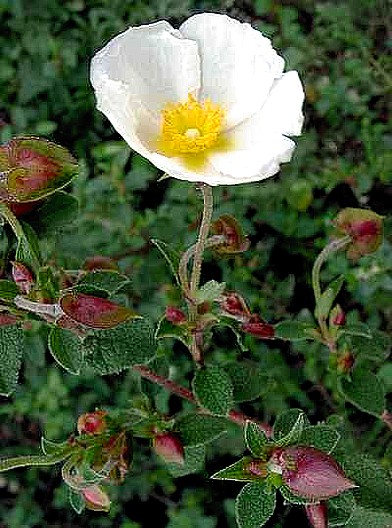
Cistus salvifolius
Cistus is a genus of flowering plants in the rockrose family Cistaceae, containing about 20 species (Ellul et al. 2002). They are perennial shrubs found on dry or rocky soils throughout the Mediterranean region, from Morocco and Portugal through to the Middle East, and also on the Canary Islands. The leaves are evergreen, opposite, simple, usually slightly rough-surfaced, 2-8 cm long; in a few species (notably Cistus ladanifer), the leaves are coated with a highly aromatic resin called labdanum. They have showy 5-petaled flowers ranging from white to purple and dark pink, in a few species with a conspicuous dark red spot at the base of each petal., and together with its many hybrids and cultivars is commonly encountered as a garden flower.
The common name rockrose is applied to the species, a name also shared by the related genera Halimium, Helianthemum and Tuberaria, all in the family Cistaceae.
Species
Cistus albanicus
Cistus albidus
Cistus chinamadensis
Cistus clusii
Cistus creticus
Cistus crispus
Cistus heterophyllus
Cistus ladanifer – Gum Rockrose
Cistus laurifolius
Cistus libanotis
Cistus monspeliensis –
Montpelier Cistus
Cistus munbyi
Cistus osbeckiaefolius
Cistus parviflorus
Cistus populifolius
Cistus psilosepalus
Cistus salviifolius – Salvia Cistus
Cistus symphytifolius
Cistus varius
They are thermophilous plants, which require open, sunny places. As with many other Cistaceae, the species of Cistus have the ability to form mycorrhizal associations with truffles (Tuber) and are thus able to thrive on poor sandy soils or rocks.
Cistus
are the only host of Cytinus hypocistis, a small parasitic plant that
lives on the roots and is noticeable only for a short period of time when in
flower. The presence of the parasite does not seem to hurt the host population.
Cistus species are used as food plants by the larvae of some Lepidoptera
species including Coleophora confluella and Coleophora
helianthemella, the latter recorded on Cistus monspeliensis.
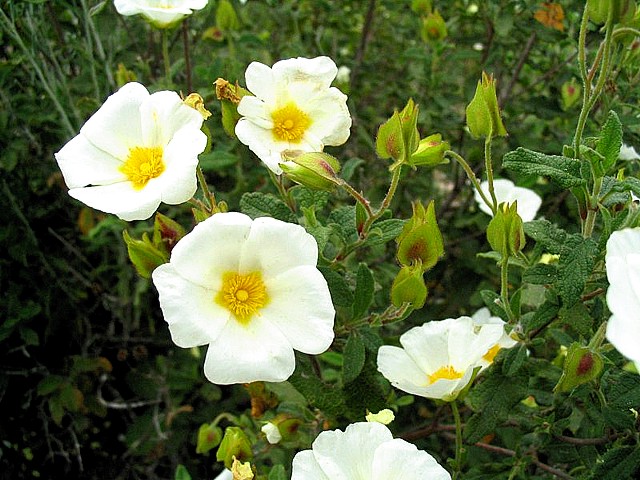
Cistus salvifolius